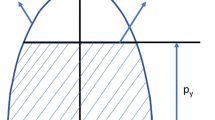Abstract
A theoretical model for the elastic–plastic contact of ellipsoid bodies is presented in this paper. Relation of the contact parameters, such as the mean contact pressure, the contact area and the contact load as a function of the contact interference are modeled in the three different contact regimes: elastic, elastic–plastic and fully plastic. The model is verified by experimental results and is compared with published theoretical models. Very good agreement between the present model and the experimental results are found compared to the prediction of the other contact models.










Similar content being viewed by others
References
Bhushan B., (1996) ASME Applied Mechanic Review 49(5):275
Greenwood J.A., Williamson J.B.P., (1966) Proc. R. Soc. London, Ser A 295:300
Timoshenko S., Godier J.N., (1951). Theory of Elasticity McGraw-Hill, New York
Greenwood J.A., Tripp J.H., (1967) ASME J. Appl. Mech. 34: 153
Greenwood J.A., Tripp J.H., (1970–1971). Proc. Instn. Mech. Eng. 185: 625
Hisakado T., (1974). Wear 28: 217
Bush A.W., Gibson R.D., Thomas T.R., (1975). Wear 35: 87
Abbott E.J., Firestone F.A., (1933) Mech. Eng. 55: 569
Pullen J., Williamson J.B.P., (1972). Proc. R. Soc. London, Ser A 27: 159
Kucharski S., Klimczak T., Polijaniuk A., Kaczmarek J., (1994). Wear 177: 1
Chang W.R., Etsion I., Bogy D.B., (1987) ASME J. Tribol. 109: 257
Johnson K.L., (1985). Contact Mechanics Cambridge University Press, Cambridge
Zhao Y., Maietta D.M., Chang L., (2000). ASME J. Tribol. 122: 86
Kogut L., Etsion I., (2002) ASME J. Appl. Mech. 69: 657
Jackson R.L., Green I., (2005). ASME J. Tribol. 127: 343
Horng J.H., (1998). ASME J. Tribol. 120: 82
Jeng Y.R., Wang P.Y., (2003). ASME J. Tribol. 125: 232
McCool J.I., (1986). ASME J. Tribol. 108: 380
H. Reussner, Druckflächenbelastung und Oberflächen verschiebung im Wälzcontact von Rotationskörpen. PhD Thesis, University of Karlsruhe, Germany, 1977 (in German)
Moes H., (2000). Lubrication and Beyond – University of Twente Lecture Notes code 115531 Enschede, The Netherlands
D. Tabor, The Hardness of Metals (Oxford university press, 1951)
Chang W.R., Etsion I., Bogy D.B., (1988) ASME J. Tribol. 110: 57
J. Jamari and D.J. Schipper, (2006) ASME J. Tribol. 128: 230
Francis H.A., (1976). ASME J Eng. Mater. Technol. 98: 272
Chaudhri M.M., Hutchings I.M., Makin P.L., (1984). Philos. Mag. A49: 493
Author information
Authors and Affiliations
Corresponding author
Appendices
Appendix A: Contact area and load of elastic elliptical contact
From the theory of elasticity, the maximum contact pressure p o, the semi-major contact ellipse radius b and the interference of an asperity ω can be written as [12]
where p is the mean contact pressure, P is the contact load, a is the semi-minor radius of the elliptic contact area and E is the effective elastic modulus as defined in equation (A.4):
The ratio of the semi-minor and semi-major contact ellipse radii, a and b, are related to the principal relative radii, R x and R y , as:
K(e) and E(e) are the complete elliptic integrals of the first and second kind, respectively:
The elastic contact area A e and the contact load P e can be expressed in terms of the contact interference ω by combining equations (A.1), (A.2) and (A.3):
Appendix B: Fully plastic contact experiment
In Ref. [23] the measurements of the contact parameter in the fully plastic contact regime were performed on copper and aluminum. Results showed that for both materials the behavior of the mean contact pressure and the contact area are similar. Experiments were done on a pin-on-disk machine where the flat specimen (SiC) was firmly mounted on a disk and the pin of the tester was replaced by a sphere specimen. A dead load system was used to apply the normal load.
The plastic contact area was measured by a new novel technique which so-called the matching and stitching method. In this method a measurement of a large area can be done by matching and stitching from sequence measurements as shown schematically in figure B.1. Figure B.2a demonstrates a typical result of the matching and stitching of plastic deformation of a sphere after compression. The change of the profile is presented in figure B.2b. Here, the ‘before’ profile is calculated based on the known initial sphere radius and the two points reference at the undeformed sphere.
Rights and permissions
About this article
Cite this article
Jamari, J., Schipper, D.J. An elastic–plastic contact model of ellipsoid bodies. Tribol Lett 21, 262–271 (2006). https://doi.org/10.1007/s11249-006-9038-3
Received:
Accepted:
Published:
Issue Date:
DOI: https://doi.org/10.1007/s11249-006-9038-3



